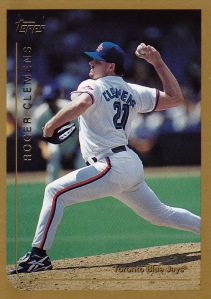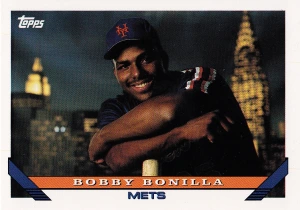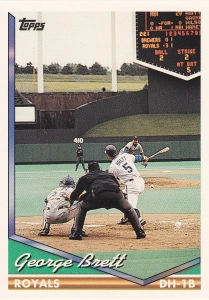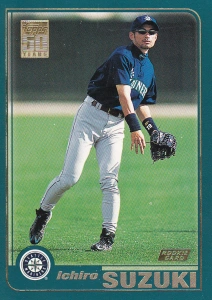On to my next post about 1999 Topps inserts. The last post covered the Nolan Ryan inserts; today’s post covers all the rest.
Aside from the Ryan reprints, none of insert sets were “continuous”; they were all specific to either series 1 or series 2. As always, the insert odds reflect hobby packs unless otherwise noted.
All-Topps Mystery Finest (33 cards, 1:36 series 2)
All-Topps Mystery Finest Refractors (33 cards, 1:144 series 2)
For the sixth straight year, Topps inserted cards with Finest technology into the base product. For the third time, this insert had the “Mystery Finest” theme. This set was inserted into series 2 packs, and actually mirrors the players from an 11-card subset that’s included in the Topps base set – the All-Topps Team. At each position – with one notable exception – there are three players who made the team, plus there are an additional three spots for rookies who made the team. All 3 players are shown on the 11-card subset in the base set, but the “mystery” idea is used for this insert set – you have to peel the black front off the card to see who your player is.

Now – on to the discrepancy I mentioned. There is no card showing second baseman, and 2 cards of first baseman. This seems to be Topps showing some laziness (or worse, just trying to get more players from a more high profile position included) before they even had the current MLB-approved monopoly! Because of this, Tino Martinez, John Olerud and Jim Thome all got cards in this set, though I’m pretty sure none of them could play second base…
There actually were a number of good second baseman in 1998. Craig Biggio was the best of the lot and clearly would have made the All-Topps team – he became only the second player (and still is) to hit 50 doubles and steal 50 bases in the same season. After him, I’d probably go Jose Offerman and Ray Durham, though Jeff Kent and Fernando Vina were also great. And the best two American League second baseman of the previous five years, Roberto Alomar and Chuck Knoblauch, were also very good – just not in the category of the other 5 guys I mentioned.
- Biggio – .325-.403-.503, 20 HR, 88 RBI, 123 R, 210 H, 51 2B, 50 SB
- Offerman – .315-.403-.438, 7 HR, 66 RBI, 102 R, 191 H, 13 3B, 45 SB
- Durham – .285-.363, .455, 19 HR, 67 RBI, 126 R, 181 H, 36 SB
The cards were available in refractor versions – I didn’t pull any. I did pull a card of one of the “undeserving” first baseman – that being Thome.

Power Brokers (20 cards, 1:36 – series 1)
Power Brokers Refractors (20 cards, 1:144 – series 1)
The Mystery Finest cards were from series 2, and they effectively replaced another insert set from series 1 that used chrome / finest technology. This set was called Power Brokers, which was a die-cut set featuring sluggers from the incredible 1998 season.

There was also a refractor version available.
Picture Perfect (10 cards, 1:8 – series 1)
There were two insert sets that came more common – 4 or 5 per box. The set for series 1 was picture perfect. This one seemed a little more aimed at kids. It featured a full-bleed, borderless design and a game with an interesting connection to the base Topps set. There was a multiple choice question on the back about the player depicted, and the way to answer it was to check out his base Topps card.

For example, for Griffey Jr., the question was – which of the following is false?
- Griffey first led the AL in homers when he was 24 years old?
- His 140 RBI led the league in 1996.
- He had more BB than SO in 1993.
- He was the #1 draft pick in 1987.
And the insert card directs you to card #100 – Griffey’s base card – to find the answer. (For those of you curious, the answer is “B” – he had 140 RBI in 1996, but it didn’t lead the league).
Record Numbers (10 cards, 1:8 – series 2)
Record Numbers Gold (10 cards, series 2 – #/d to the specific record depicted)
The insert set that came 4-5 per box in series 2 was called record numbers. This showcased a record reached by 10 different players in 1998. For example, Mark McGwire hit 70 homers, Sammy Sosa hit 20 homers in a month, Griffey became the youngest player to reach 350 homers, Cal Ripken ended his consecutive games streak at a record 2,632 games. These cards have a striking similarity to the 1995 Topps design.

There is also a gold version serial numbered to the specific record depicted – which makes for a pretty wide variety in availability – from Sosa, Wood and Clemens at 20 all the way to Ripken’s 2,632.
Lords of the Diamond (15 cards, 1:18 – series 1)
Topps inserted 2 “shinies” into series 1. The first of these was another die-cut insert set called Lords of the Diamond. I’m not sure if this is an attempted shout-out to Tolkien, but these are those kind of cards with the silver, shiny background where you actually get a better look at what’s in said background when viewing a scan of the card. Looking at these cards in-hand, and it just looks like a whole lot of shiny!

New Breed (15 cards, 1:18 – series 1)

The other shiny set was called New Breed. Inserted at the same rate and containing the same number of cards (15) as the Lords of the Diamond, this set features younger players who at the time were viewed as the future of the game.
All-Matrix (30 cards, 1:18 – series 2)

Topps also had as “shiny” counterpart in series 2, though it came in the form of just one set of 30 cards instead of 2 sets of 15. The All-Matrix set consisted of 3 groupings – players in the “40-club” for the 13 players who had hit 40 home runs in 1998, “99 Rookies” for 10 players who could battle for Rookie of the Year in the upcoming season, and “Club K” for the 7 best strikeout pitchers in the game.
Hall of Fame Collection (10 cards, 1:12 – series 1 hobby)

This set was hobby only and is the first insert set featuring multiple retired players in the history of the Topps flagship brand. These cards are pretty nice – they feature 10 different Hall of Famer players with their Cooperstown plaque as a background and a black and white photo in the foreground. I’m not sure why there isn’t a series 2 equivalent here – maybe Topps meant to do a continuation but didn’t sign enough former players? It leaves series 2 without a “hobby exclusive”.
 Brewery: Ommegang Brewery, Cooperstown, NY
Brewery: Ommegang Brewery, Cooperstown, NY















































